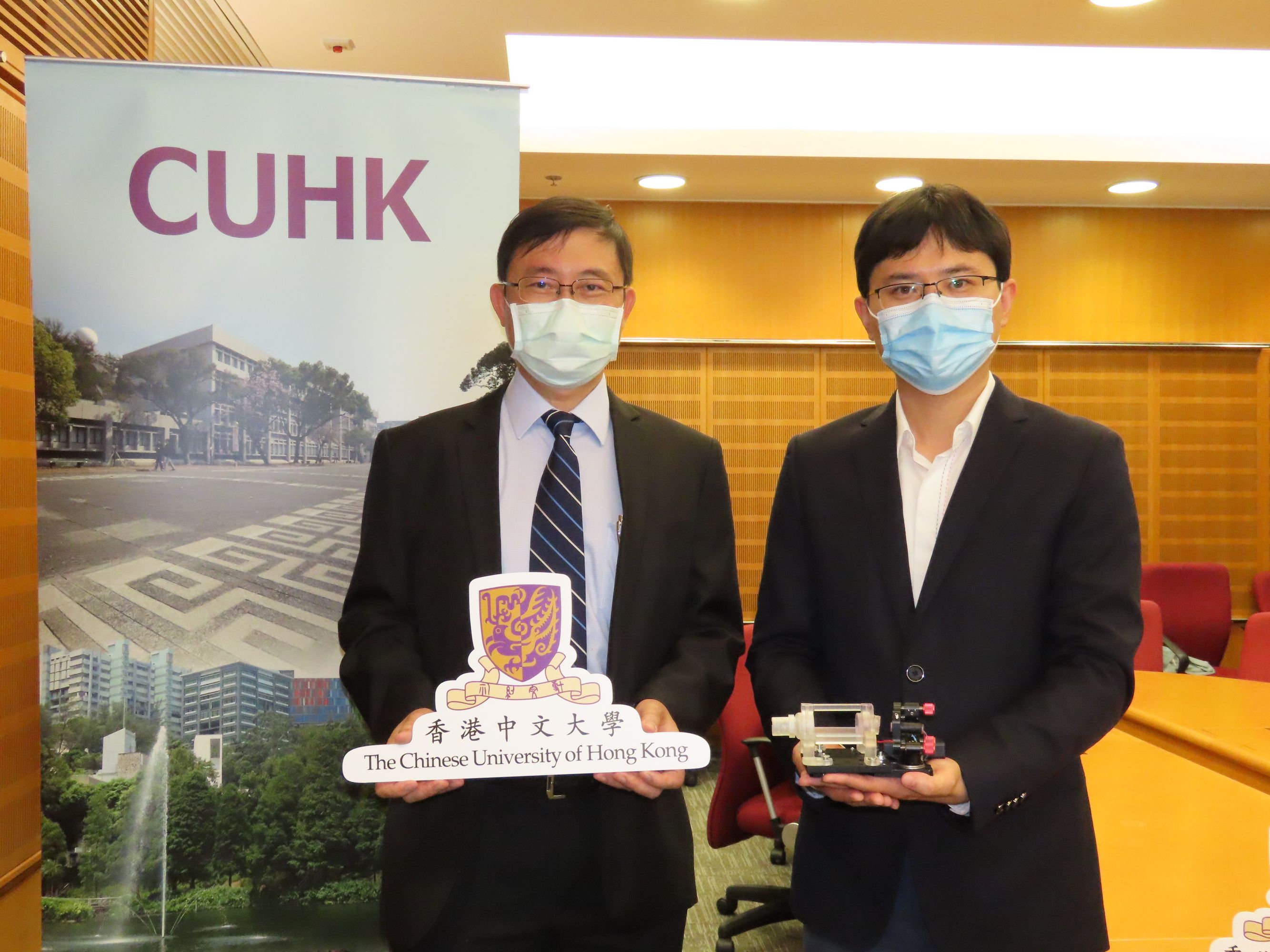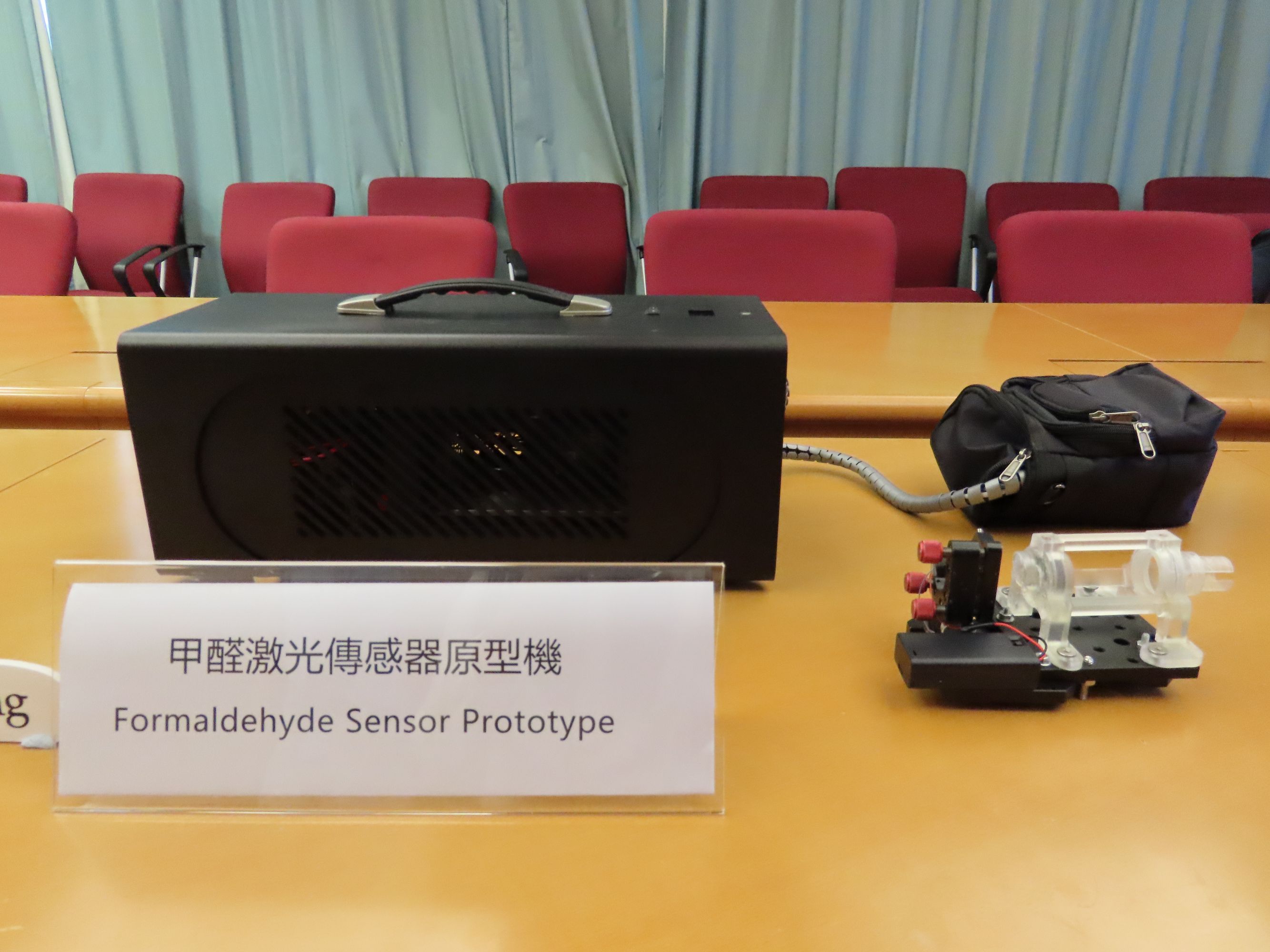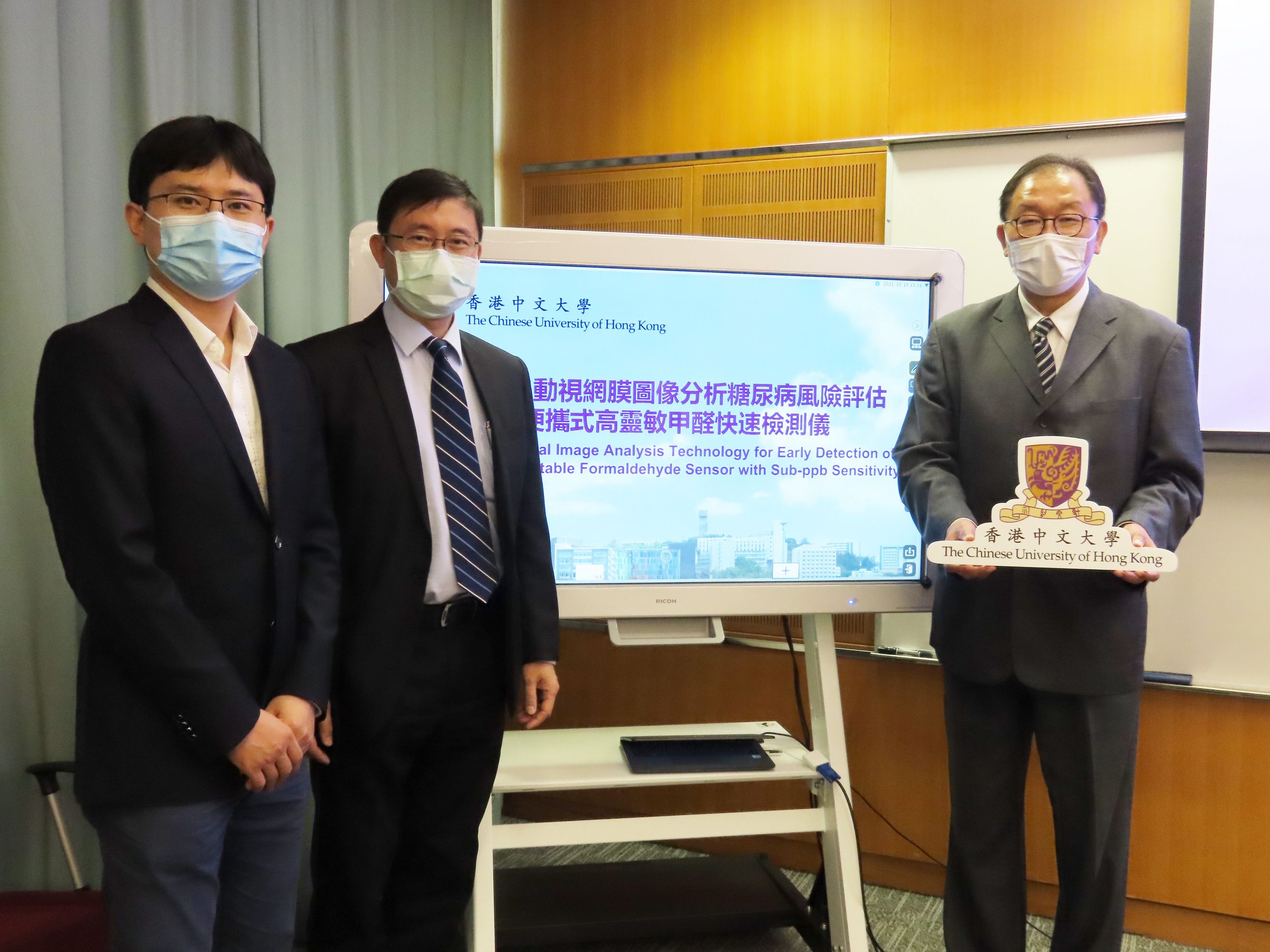The Chinese University of Hong Kong (CUHK) is dedicated to promoting innovation through technology transfer to society and industry. Through participating in local technology exhibitions, the University seeks to demonstrate the latest findings and inventions to the public while maintaining contact with industry to encourage communication and industrial collaboration. In October, CUHK is taking part in three local large-scale technology exhibitions, namely the InnoCarnival 2021 held from 23 to 31 October at Science Park, and the International ICT Expo 2021 and the Hong Kong International Medical and Healthcare Fair 2021 held from 27 to 30 October at the Hong Kong Convention and Exhibition Centre. There will be more than 30 new research projects on display, two of which are the “Automatic Retinal Image Analysis (ARIA) Technology” for early detection of the risk of undiagnosed diabetes and the “Portable Formaldehyde Sensor with Sub-ppb Sensitivity”. Automatic Retinal Image Analysis (ARIA) Technology – Early Detection of the Risk of Undiagnosed Diabetes The research team led by Professor Benny ZEE, Director of the Centre for Clinical Research and Biostatistics, the Jockey Club School of Public Health and Primary Care at CUHK, has successfully developed a convenient, non-invasive and painless technology, namely “Automatic Retinal Image Analysis (ARIA) Technology”, that can quickly assess the risk of diabetes simply by analysing the fundus images. By offering a convenient and accurate method for the general population, those who have a high risk of diabetes in the community will be alerted to look for prevention. The study was presented at the 57th Annual Meeting of the European Association for the Study of Diabetes (EASD). The ARIA technology is currently used as a community risk assessment tool for health promotion and disease prevention, including chronic diseases such as stroke and cognitive health risks. The ARIA technology used the machine-learning-based assessment method to examine retinal images. Based on 2,221 cases, the study concluded that the innovative method can be an effective risk assessment tool for diabetes screening, with a sensitivity of 92.0%, a specificity of 96.2%, and an overall accuracy of 94.4%. This method has been tested using two separate data, one from Hong Kong with 1,394 cases, including 734 controls from community subjects and 660 diabetes. A sensitivity of 99.5% and a specificity of 91.1% were obtained. The team has also validated the method using retinal images from its collaborator in the UK with 1,682 diabetes and obtained a sensitivity of 98.0%. These results show that the ARIA for diabetes risk works in both Asian and Caucasian populations. “Our eyes enclose tremendously important clues and signals to our health. What we need is the right technology for their interpretation,’ said Professor Benny ZEE. Knowledge transfer with social impact Professor Zee has devoted himself to the study of ARIA for more than ten years. ARIA technology has previously been applied to assess the risk of stroke (ARIA-stroke risk) and white matter hyperintensities as an early risk factor of dementia (ARIA-WMH). The team is now working on ARIA technology for the risk assessment of mental health disorders, anaemia, ASD (validation study – age between 2 and 6), coronary heart disease, and diabetic kidney disease. Professor Zee foresees ARIA becoming a widely used standard risk assessment tool, promoting disease prevention and translating the research results into applications that will have a substantial impact on society. Portable Formaldehyde Sensor with Sub-ppb Sensitivity Five Advantages: High Sensitivity, High Accuracy, Calibration Free, Interference Free, and Fast Response Formaldehyde is a carcinogen which is transparent and odourless. It causes strong irritation to human beings in high concentrations. Although present in nature with a trace amount, its main indoor sources are construction materials and furniture, which may release formaldehyde for as long as 3 to 15 years and are regarded as “invisible killers”. Therefore, actions to detect and remove formaldehyde are often taken after interior renovation of apartments or offices. The World Health Organisation (WHO) recommended that the concentration of formaldehyde in indoor air should be no higher than 80 ppb, or else it will be harmful. Currently, the portable formaldehyde detectors on the market use electrochemical methods and are only applicable for formaldehyde detection with a concentration higher than 300 ppb. Also, calibrations are required before use while the detectors may be easily interfered with by other gases, leading to a low accuracy. Precise formaldehyde analysis can be conducted using scientific instruments such as Gas Chromatography-Mass Spectrometry (GC-MS), which demands a complex sampling and preprocessing. The whole process may take a few hours which makes real-time, on-site detection impossible. The team led by Professor Wei REN, Associate Professor from the Department of Mechanical and Automation Engineering, CUHK, has invented a new low-cost portable infrared laser absorption sensor for formaldehyde detection. The sensor applies multiple reflection, enhanced wavelength modulation absorption spectrum technology which enables accurate and fast detection of formaldehyde. The sensor can achieve sub-ppb sensitivity without the need for calibration. It has shown a formaldehyde detection limit of 0.6 ppb for a measurement time of only 1 second. This sensor also shows no interference from other gases in the environment. The high accuracy may fulfil the formaldehyde limit for the indoor air quality objective set by the Hong Kong SAR Government. It is powered by a lithium battery and easy to carry, which allows detection anytime and anywhere. As no consumption of chemicals is involved, this sensor is more durable than those applying the electrochemical method, and also has a higher stability. The team is also actively inventing an optical sensor for detecting different gases. The detection relies on the source of the laser. By putting different laser chips into the sensor, the specific laser wavelength may help to identify the fingerprint of the particular gas. The team is now designing the sensor to detect five harmful gases at the same time, such as carbon monoxide, nitrogen oxides (NO and NO2), and ammonia and sulfur dioxide. The detector may be applied in hospitals and homes for indoor air detection, cutting-edge experiment equipment and industrial safety detection. Professor REN Wei said, “Many components can be 3D printed, making the sensor smaller, cheaper, and more stable. It is estimated that the sensor will be launched on the market in six months to a year. It will be set at a price similar to normal portable formaldehyde detectors, after mass production.” 13 Research Projects on display at the InnoCarnical 2021 CUHK is participating in the InnoCarnival 2021 organised by the Innovation and Technology Commission from 23 to 31 October at Science Park. Members of the public are welcome to visit CUHK’s booths to learn more about the “Portable Formaldehyde Sensor with Sub-ppb Sensitivity” and 12 other innovative research projects. This year, an online exhibition and an offline to online interactive gaming platform with prizes are introduced for the first time. Participants can increase their understanding of the displayed projects by visiting the exhibition in person and joining the offline to online engagement activities. 40 prizes related to scientific research will be given to the winners. Participants engaged in the activities at the physical booth can also redeem a goody bag. Date: 23-31 October 2021 Time: Sat & Sun: 10 am – 6 pm; Mon to Fri: 10 am – 5 pm Venue: Hong Kong Science Park Offline to Online interactive game: https://innocarnival2021.cintec.cuhk.edu.hk/home.php Official website: https://innocarnival.hk/en/ 11 Research Projects on display at the International ICT Expo 2021 Date: 27-30 October 2021 Time: 27-29 October (Wed-Fri): 10 am – 6 pm; 30 October (Sat): 10 am – 5 pm Venue: Hall 1E, Hong Kong Convention and Exhibition Centre Booth no.: 1E-C08 Official website: https://event.hktdc.com/fair/ictexpo-en 11 Research Projects on display at the Hong Kong International Medical and Healthcare Fair 2021 Date: 27-30 October 2021 Time: 27-29 October (Wed-Fri): 10 am – 6 pm; 30 October (Sat): 10 am – 5 pm Venue: Hall 1C, Hong Kong Convention and Exhibition Centre Booth no.: 1C-D23 Official website: https://event.hktdc.com/fair/hkmedicalfair-en About Professor Benny Chung Ying ZEE Professor Benny Zee is Director, Office of Research and Knowledge Transfer Services (ORKTS) at CUHK. He is also Professor and Director of the Centre for Clinical Research and Biostatistics (CCRB) of the Jockey Club School of Public Health and Primary Care, and Director of Clinical Trials and Biostatistics Lab in the CUHK Shenzhen Research Institute (SZRI). He holds honorary appointments in the Department of Clinical Oncology and the Department of Statistics at CUHK. He was also the Chairman of the Joint CUHK-NTEC Clinical Research Ethics Committee from 2006 to 2020. Professor Zee obtained his PhD degree in Biostatistics from the University of Pittsburgh USA in 1987. He then joined the National Cancer Institute of Canada Clinical Trials Group as Senior Biostatistician, and was a faculty member in the Department of Community Health and Epidemiology and the Department of Mathematics and Statistics at Queen’s University in Canada from 1987 to 2001. He has remained as an adjunct professor with Queen’s University since he joined CUHK and is actively promoting international academic activities and collaborations. Professor Zee has a strong interest in various aspects of multi-centre clinical trials, including statistical methods, data management, drug and medical device development. On the methodological side, he is active in Biostatistics research, especially in the area of clinical trials design, bioinformatics, quality of life, data & safety monitoring and other statistical issues. He has experience in the development of efficient data management procedure using advanced computer technology for “big data analytics” and “machine learning”, plus ample experience in working with industry to design and to carry out clinical trials that satisfy both academic interest and industry objectives. He has tremendous experience in the development of infrastructure such as the Ethics Committee, GCP Centre and quality assurance teams to carry out clinical research in hospitals that satisfies regulatory and international requirements. He is also active in medical devices development such as “automatic retinal imaging analysis (ARIA)” and serves in the Centre for Entrepreneurship at CUHK. He has published more than 250 international peer reviewed journal articles, a number of US and international patents and serves on various committees including advisory committees for drug development and data & safety monitoring committees for international drug trials. About Professor Wei REN Professor Wei REN received his PhD degree from Stanford University in 2013. He is now an Associate Professor in the Department of Mechanical and Automation Engineering at CUHK. His research aims to develop new technologies and understand basic principles in laser spectroscopy and optical gas sensing. His laboratory places a strong emphasis on entrepreneurship in academic pursuits and recently spun out LaSense Technology that offers ultrasensitive gas sensing systems for the environmental protection and energy sectors. Professor Ren serves as the Co-Editor of Springer journal Applied Physics B. He is the senior member of the Optical Society, and the recipient of the Excellent Young Scientists Fund of the National Natural Science Foundation of China (2021). |
|




